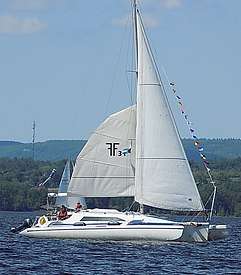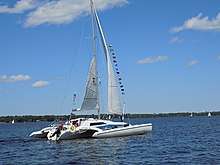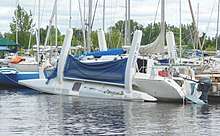F-31 Sport Cruiser
The F-31 Sport Cruiser is a family of American trailerable trimaran sailboats that was designed by New Zealander Ian Farrier and first built in 1991.[1][2] The boats were built by Corsair Marine in the United States but are now out of production.[1][3]
 | |
| Development | |
|---|---|
| Designer | Ian Farrier |
| Location | United States |
| Year | 1991 |
| Builder(s) | Corsair Marine |
| Boat | |
| Boat weight | 3,630 lb (1,647 kg) |
| Draft | 5.50 ft (1.68 m) with daggerboard down |
| Hull | |
| Type | Trimaran |
| Construction | Fiberglass |
| LOA | 30.83 ft (9.40 m) |
| LWL | 30.00 ft (9.14 m) |
| Beam | 22.42 ft (6.83 m) |
| Engine type | Outboard motor |
| Hull appendages | |
| Keel/board type | daggerboard |
| Rudder(s) | internally-mounted spade-type rudder |
| Rig | |
| Rig type | Bermuda rig |
| Sails | |
| Sailplan | Fractional rigged sloop |
| Total sail area | 599 sq ft (55.6 m2) |
The F-31 is the production development of the Farrier F-9, which were built by custom shops in small numbers and by amateur builders from plans.[1][4] The first F-9 prototype was launched on 29 September 1991.[5][6][7]
Design



The F-31 is a small recreational trimaran, built predominantly of fiberglass. The hull is constructed with a rigid PVC foam core, vacuum bagged to the skins, while the structural beams are reinforced with carbon fiber.[1][7]
It has a fractional sloop rig, a plumb stem, a reverse transom, an internally-mounted spade-type rudder controlled by a tiller and a retractable daggerboard, mounted at 18°, with the daggerboard trunk stepping the mast. The outrigger floats are folding for storage or ground transportation on a trailer, with a maximum width of under eight feet for highway transport. The outrigger floats fold into cutouts in the lower hull to reduce trailering width. When deployed the outriggers are set at a fixed 8° to the hull, so that they are upright and thus symmetrical, when each is in the water. Due to the employment of a daggerboard, the design can easily be beached.[1][7]
The boat is normally fitted with a small outboard motor of typically 9.9 to 15 hp (7 to 11 kW) for docking and maneuvering.[1][7]
Operational history
In 1992 the F-31 was named the Australian Sailboat of the Year.[5] In April 1992 Fred Gan's F-31 Ostac Triumph won the bi-annual Australian Offshore Multihull Championships. In the associated Brisbane to Gladstone Ocean Race, Bobsled, a 67-foot, million dollar, racing monohull boat, sponsored by Société Générale,[8] made headlines in breaking the monohull record by an impressive hour and a half. The trailerable F-31 caught and passed Bobsled, finishing an hour and fifteen minutes ahead.[5]
In a 2000 review, writer Bob Perry of Sailing Magazine wrote of the F-31, "In looking at the accommodations, it would be better not to compare this design to a monohull with a similar LOA but, instead, to compare displacements. There is no question that the 31-foot Farrier tri has less interior volume than a standard 31-foot monohull, but you cannot trail[er] most 31-foot monohulls. The F-31 has comfortable accommodations for two couples, and boat speed that will blow the doors off a 31-foot monohull...Ian designs handsome boats. The F-31 is no exception... Just be aware that this 31-footer is capable of sailing with some big monohulls."[7]
Variants
- F-9A
- The initial F-9, designed for amateur construction from plans. More than 300 completed.[9]
- F-9AX
- A version of the F-9A with expanded interior space, with a 15% wider center hull for more room and a 16% higher load capacity. Trailering beam was also increased to 2.9 m (9.5 ft).[9]
- F-9R
- A high performance racing version of the F-9A with a rotating mast.[9]
- F-31 Sport Cruiser
- This model was designed by Ian Farrier and built by Corsair Marine. It improved over the F-9 in having a smaller folded width for trailering of under 8 ft (2.4 m). It has a length overall of 30.83 ft (9.4 m), a waterline length of 30.00 ft (9.1 m) and displaces 3,630 lb (1,647 kg). The boat has a draft of 5.50 ft (1.68 m) with the daggerboards down and 1.67 ft (0.51 m) with the daggerboards up. The fresh water tank has a capacity of 20 U.S. gallons (76 L; 17 imp gal). The boat has a hull speed of 7.34 kn (13.59 km/h).[1][7][10]
- Corsair 31
- This model was designed by Ian Farrier and built by Corsair Marine. After Corsair and Ian Farrier ended their business relationship in 2000, Corsair continued to develop the F-31's design and renamed the modified design the Corsair 31. It has a length overall of 30.83 ft (9.4 m), a waterline length of 30.00 ft (9.1 m) and displaces 4,600 lb (2,087 kg). The boat has a draft of 5.50 ft (1.68 m) with the daggerboards down and 1.33 ft (0.41 m) with the daggerboards up. Options included a racing package, with a bowsprit and carbon fiber spars. It was built in an aft-cockpit and center-cockpit version. It has a hull speed of 7.34 kn (13.59 km/h).[4][9][11]
References
- Browning, Randy (2018). "F-31 Sport Cruiser sailboat specifications and details". sailboatdata.com. Retrieved 25 July 2018.
- Browning, Randy (2018). "Ian Farrier". sailboatdata.com. Retrieved 2 July 2018.
- Browning, Randy (2018). "Corsair Marine". sailboatdata.com. Retrieved 25 July 2018.
- Browning, Randy (2018). "Corsair 31/F-31 sailboat specifications and details". sailboatdata.com. Retrieved 25 July 2018.
- "Farrier Marine: History".
- "Original Report on the First F-9/F-31 launching".
- Perry, Bob (25 August 2000). "Perry Design Review: Corsair F-31 - Farrier follow-up to the hot F-27". Sailing Magazine. Retrieved 25 July 2018.
- "A Comparison: Are Multihulls Worth the Extra Cost?".
- "Farrier Marine: Trimarans".
- InterVisionSoft LLC (2018). "Sailboat Specifications for TRI - F-31 SP. Cruiser". Sailing Joy. Retrieved 25 July 2018.
- InterVisionSoft LLC (2018). "Sailboat Specifications for Corsair 31/F-31". Sailing Joy. Retrieved 25 July 2018.
External links
